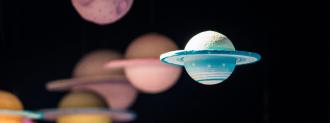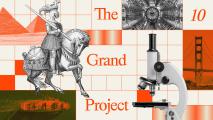Astronomers look for potential signs of life in other solar systems by studying their sun and looking for a flicker of light as an orbiting planet passes by. From that change in light patterns, they can deduce the planet’s size, orbit, and (often) the composition of the atmosphere — all clues to its suitability for life. Now, a team of researchers realized that if we can do that, surely ET beings on habitable exoplanets could observe Earth in the same way.
“From the exoplanets’ point-of-view, we are the aliens,” Lisa Kaltenegger, a Cornell University astronomer, said in a statement.
Kaltenegger and Jackie Faherty at the American Museum of Natural History searched the heavens to find out from which stars aliens could potentially see Earth. She found that the cosmos aligned for more than 2,000 star systems to have the correct vantage point to see Earth pass in front of our sun.
“From the exoplanets’ point-of-view, we are the aliens.”
Lisa Kaltenegge
What they found: The team looked at data from the Gaia space telescope on the positions and motions of our galaxy’s stars.
“Let’s reverse the viewpoint to that of other stars and ask from which vantage point other observers could find Earth as a transiting planet,” Kaltenegger said in a statement.
They analyzed the sightlines of more than 300,000 stars in our neighborhood.
They did simulations projecting the stars’ movements over 10,000 years. They then determined the amount of time each star was optimally positioned to view Earth. In total, the average length of time these stars could see Earth was 6,914 years — that’s almost seven millennia that Earth was in full view for any potential alien life looking for habitable exoplanets, reports New Scientist.
A whopping 1,715 nearby stars (within about 300 light-years), and the planets surrounding them, have had a clear view of Earth at some point in the era of human agricultural civilization. 75 of these planets could even possibly detect radio signals from Earth, and seven of those have planets that have characteristics of habitable exoplanets.
If any theoretical aliens on those systems have the smarts and telescopes to find habitable exoplanets (like Earth), they could know we are here.
What this means: If humans can figure out how to find other habitable exoplanets, it is certainly possible for another lifeform. Maybe they’ve been watching us for decades, or they could notice us soon. The team calculated that 319 stars could be in the right vantage point to have a peek at Earth in the next 5,000 years.
That may seem like a long time, but it won’t be long until one particular star, known as Teegarden’s Star, will be in the ideal place to see our sun and notice a twinkle of light as Earth passes in front of the sun.
“If they have the same technique as we do, and if there is a ‘they,’ then they wouldn’t know yet that we exist,” Kaltenegger told NPR. “In 29 years, they would be able to see us.”
This example that the study, published in the journal Nature, reports is that two Earth-sized planets, traveling around Teegarden’s star just 12 light-years away, could support life. And, if they did, it’s possible the ET beings know we are here, by detecting radio signals escaping from Earth. Teegarden is among several stars that could see Earth in the near future.
“These worlds might be worth the trouble of studying further, because we know they can see us,” Kaltenegger told New Scientist. “Who would have the most incentive to send us a signal? The ones who could have found us.”
We’d love to hear from you! If you have a comment about this article or if you have a tip for a future Freethink story, please email us at [email protected].






